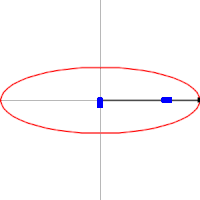In nature, approximations of parabola and paraboloids (such as catenate curves) are found in many diverse situations. The best-known instance of the parabola in the history of physics is the trajectory of a particle or body in motion under the influence of a uniform gravitational field without air resistance (for instance, a baseball flying through the air, neglecting air friction).
The parabolic trajectory of projectiles was discovered experimentally by Galileo in the early 17th century, who performed experiments with balls rolling on inclined planes. He also later proved this mathematically in his book Dialogue Concerning Two New Sciences.For objects extended in space, such as a diver jumping from a diving board, the object itself follows a complex motion as it rotates, but the center of mass of the object nevertheless forms a parabola. As in all cases in the physical world, the trajectory is always an approximation of a parabola. The presence of air resistance, for example, always distorts the shape, although at low speeds, the shape is a good approximation of a parabola. At higher speeds, such as in ballistics, the shape is highly distorted and does not resemble a parabola.
Another situation in which parabola may arise in nature is in two-body orbits, for example, of a small planetoid or other object under the influence of the gravitation of the sun. Such parabolic orbits are a special case that are rarely found in nature. Orbits that form a hyperbola or an ellipse are much more common. In fact, the parabolic orbit is the borderline case between those two types of orbit. An object following a parabolic orbit moves at the exact escape velocity of the object it is orbiting, while elliptical orbits are slower and hyperbolic orbits are faster.
Approximations of parabola are also found in the shape of the main cables on a simple suspension bridge. The curve of the chains of a suspension bridge is always an intermediate curve between a parabola and a catenate, but in practice the curve is generally nearer to a parabola, and in calculations the second degree parabola is used.[9][10] Under the influence of a uniform load (such as a horizontal suspended deck), the otherwise hyperbolic cable is deformed toward a parabola. Unlike an inelastic chain, a freely hanging spring of zero unstressed length takes the shape of a parabola.
Paraboloids arise in several physical situations as well. The best-known instance is the parabolic reflector, which is a mirror or similar reflective device that concentrates light or other forms of electromagnetic radiation to a common focal point, or conversely, collimates light from a point source at the focus into a parallel beam. The principle of the parabolic reflector may have been discovered in the 3rd century BC by the geometer Archimedes, who, according to a legend of debatable veracity, constructed parabolic mirrors to defend Syracuse against the Roman fleet, by concentrating the sun's rays to set fire to the decks of the Roman ships. The principle was applied to telescopes in the 17th century. Today, paraboloid reflectors can be commonly observed throughout much of the world in microwave and satellite dish receiving and transmitting antennas.
It can be seen in architecture as well. For instance the Oval Office of the The White House is essentially two Parabolas facing one another and as such an interesting effect happens. Two people, each standing at one of the focal points 21 feet apart, can whisper secretly to one another despite entertaining the company of others.
Paraboloids are also observed in the surface of a liquid confined to a container and rotated around the central axis. In this case, the centrifugal force causes the liquid to climb the walls of the container, forming a parabolic surface. This is the principle behind the liquid mirror telescope.
Aircraft used to create a weightless state for purposes of experimentation, such as NASA's “Vomit Comet,” follow a vertically parabolic trajectory for brief periods in order to trace the course of an object in free fall, which produces the same effect as zero gravity for most purposes.
Aircraft used to create a weightless state for purposes of experimentation, such as NASA's “Vomit Comet,” follow a vertically parabolic trajectory for brief periods in order to trace the course of an object in free fall, which produces the same effect as zero gravity for most purposes.
Vertical curves in roads are usually parabolic by design.














 and if
and if  is the
is the  and
and 


 , is the length of the arc between X and the vertex of the parabola.
, is the length of the arc between X and the vertex of the parabola.
 and
and 
 , must be positive. The quantity ln(a), sometimes written as loge(a), is the
, must be positive. The quantity ln(a), sometimes written as loge(a), is the 

 ) is
) is



 , then the area is
, then the area is  .
.



